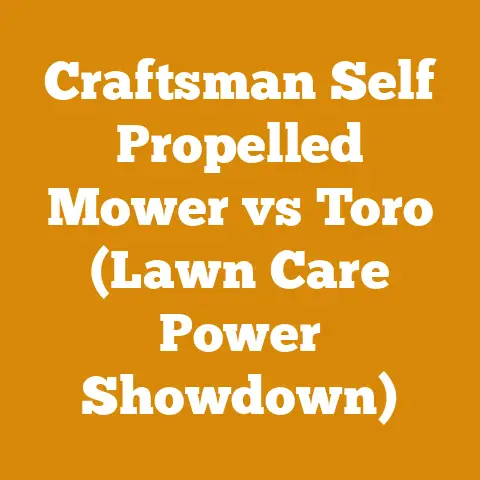Amazon Firebrick Longevity Explained (Expert Wood Heater Insights)
Have you ever wondered why the firebrick in your wood heater cracks, crumbles, or simply gives up the ghost after only a season or two? It’s a question I’ve wrestled with for years, both as a seasoned wood heater user and someone deeply involved in the world of wood processing and firewood preparation. Through my experiences, countless conversations with fellow enthusiasts, and a bit of hands-on research, I’ve uncovered the secrets to maximizing firebrick longevity. Let’s dive into the fascinating world of firebrick, exploring everything from its composition to the best practices for ensuring it lasts.
Understanding Firebrick: The Foundation of Longevity
Before we can talk about extending the life of firebrick, we need to understand what it is and what it does. Firebrick isn’t just any brick; it’s a specially designed refractory material engineered to withstand extreme temperatures.
What is Firebrick?
Firebrick is composed primarily of refractory ceramic materials like alumina and silica. These materials are carefully selected and processed to create a brick that can endure the intense heat inside a wood heater, fireplace, or kiln.
The Role of Firebrick in Wood Heaters
Firebrick serves several crucial functions in a wood heater:
- Heat Retention: It absorbs and stores heat, radiating it back into the room even after the fire dies down.
- Protection: It shields the metal firebox from direct flame impingement, preventing warping and premature failure.
- Combustion Efficiency: By maintaining high temperatures, it helps to ensure more complete combustion of the wood, reducing creosote buildup and emissions.
Types of Firebrick
Not all firebrick is created equal. Different types are available, each with its own properties and ideal applications:
- Standard Firebrick: The most common type, suitable for general use in wood heaters and fireplaces.
- High-Alumina Firebrick: Contains a higher percentage of alumina, making it more resistant to high temperatures and chemical attack. Ideal for high-performance applications.
- Insulating Firebrick: Less dense than standard firebrick, offering excellent insulation properties. Often used as a secondary lining to further reduce heat loss.
Factors Affecting Firebrick Lifespan: Why They Fail
Understanding the common causes of firebrick failure is the first step in preventing it. Over the years, I’ve observed several key factors that contribute to the demise of these heat-resistant heroes.
Thermal Shock: The Silent Killer
Thermal shock occurs when firebrick is subjected to rapid temperature changes. This can happen when a cold stove is suddenly blasted with a hot fire, or when water is splashed onto hot bricks.
- Expansion and Contraction: Rapid heating causes the firebrick to expand quickly, while rapid cooling causes it to contract. This repeated expansion and contraction can create internal stresses, leading to cracking and spalling (surface flaking).
- Prevention: To minimize thermal shock, always start with a small fire and gradually increase the heat. Avoid throwing large logs onto a cold firebed. Never introduce water or other liquids into a hot stove.
Overfiring: Exceeding Temperature Limits
Every type of firebrick has a maximum operating temperature. Exceeding this limit can cause the brick to soften, deform, and eventually fail.
- Wood Type: Burning certain types of wood, like fast-burning softwoods, can generate extremely high temperatures.
- Airflow: Excessive airflow to the fire can also lead to overfiring.
- Mitigation: Use a mix of hardwood and softwood to control the fire’s intensity. Ensure your stove’s air controls are functioning properly and avoid over-stoking the fire.
Chemical Attack: The Corrosive Culprit
The combustion process releases various chemicals, including acidic gases and creosote. These substances can react with the firebrick, causing it to deteriorate over time.
- Creosote: A byproduct of incomplete combustion, creosote contains corrosive compounds that can attack the firebrick.
- Wood Treatment: Burning treated wood releases harmful chemicals that can significantly shorten firebrick life.
- Solutions: Burn only dry, seasoned wood to minimize creosote production. Ensure proper ventilation and airflow to promote complete combustion. Avoid burning treated wood at all costs.
Physical Abuse: The Accidental Destroyer
Sometimes, firebrick failure is simply the result of physical damage.
- Log Impact: Dropping heavy logs onto the firebrick can cause cracks or fractures.
- Ash Removal: Using a metal shovel or poker to aggressively scrape ash can also damage the bricks.
- Solutions: Handle logs carefully when loading the stove. Use a soft brush or vacuum to remove ash. Consider installing a grate to protect the firebrick from direct log impact.
Moisture: The Hidden Weakener
Moisture can penetrate firebrick, especially during periods of inactivity. When the stove is fired up, this moisture turns to steam, creating internal pressure that can weaken the brick.
- Storage: Storing firewood indoors can introduce moisture to the bricks.
- Condensation: Condensation inside the stove during periods of disuse can also saturate the firebrick.
- Prevention: Store firewood in a dry, well-ventilated area. Consider placing a desiccant inside the stove during the off-season to absorb moisture.
Choosing the Right Firebrick: A Matter of Selection
Selecting the appropriate firebrick for your wood heater is crucial for ensuring its longevity. Don’t just grab the cheapest option; consider the specific demands of your stove and your burning habits.
Matching Firebrick to Your Stove
- Manufacturer Specifications: Always consult your wood heater’s manual to determine the correct type and dimensions of firebrick.
- Heat Output: If you frequently burn hot fires or use your stove as your primary heating source, consider upgrading to a higher-quality firebrick with a higher alumina content.
- Stove Design: Some stoves have unique firebrick configurations that require specific shapes and sizes.
Evaluating Firebrick Quality
- Density: Denser firebrick generally offers better heat retention and durability.
- Porosity: Low porosity indicates a tighter structure, making the firebrick less susceptible to moisture absorption and chemical attack.
- Composition: Look for firebrick with a high alumina content for improved high-temperature performance.
Sourcing Firebrick
- Local Suppliers: Check with local fireplace or stove shops for high-quality firebrick. They can often provide expert advice and custom cutting services.
- Online Retailers: Online retailers offer a wide selection of firebrick, but be sure to read reviews and compare specifications carefully.
- Direct from Manufacturers: For large quantities or specialized applications, consider purchasing directly from a firebrick manufacturer.
Installation Best Practices: Setting the Stage for Success
Proper installation is just as important as choosing the right firebrick. A poorly installed firebrick can fail prematurely, even if it’s made of the highest quality materials.
Preparing the Firebox
- Cleaning: Remove all old firebrick, ash, and debris from the firebox.
- Inspection: Inspect the firebox for any signs of damage, such as cracks or warping. Repair any damage before installing the new firebrick.
- Measurements: Double-check the dimensions of the firebox and the firebrick to ensure a proper fit.
Mortar or No Mortar?
The use of mortar in firebrick installation is a matter of debate. Some manufacturers recommend it, while others advise against it.
- Mortar Benefits: Mortar can help to create a tighter seal, preventing air leaks and improving combustion efficiency. It can also provide additional support for the firebrick.
- Mortar Drawbacks: Mortar can crack and crumble over time, requiring periodic replacement. It can also make it more difficult to remove and replace firebrick in the future.
- My Recommendation: If your stove manufacturer recommends mortar, use a high-quality refractory mortar specifically designed for firebrick. Apply a thin, even layer to the back and sides of each brick. If mortar is not recommended, ensure a snug fit between the firebrick and the firebox.
Proper Brick Placement
- Tight Fit: Ensure each firebrick fits snugly against the firebox walls and adjacent bricks.
- Staggered Joints: If using multiple rows of firebrick, stagger the joints to improve structural integrity.
- Secure Fit: If necessary, use shims or wedges to secure the firebrick in place.
Firewood Preparation: Fueling Firebrick Longevity
The type of firewood you burn has a significant impact on firebrick lifespan. Burning the wrong type of wood, or burning wood that isn’t properly seasoned, can lead to overheating, creosote buildup, and accelerated firebrick degradation.
The Importance of Seasoned Wood
- Moisture Content: Dry, seasoned wood burns hotter and cleaner than green wood. Aim for a moisture content of 20% or less.
- Creosote Reduction: Burning seasoned wood minimizes creosote production, reducing the risk of chemical attack on the firebrick.
- Efficiency: Dry wood produces more heat per pound, making your wood heater more efficient and reducing your firewood consumption.
Wood Species Selection
- Hardwoods vs. Softwoods: Hardwoods like oak, maple, and ash burn hotter and longer than softwoods like pine and fir.
- Resin Content: Avoid burning wood with high resin content, as it can produce excessive smoke and creosote.
- My Preference: I prefer a mix of hardwoods and softwoods. Hardwoods provide sustained heat, while softwoods are useful for starting fires and quickly warming up the stove.
Proper Wood Storage
- Elevated Storage: Stack firewood on pallets or racks to keep it off the ground and promote airflow.
- Covering: Cover the top of the woodpile to protect it from rain and snow.
- Ventilation: Ensure adequate ventilation around the woodpile to allow for proper drying.
Firewood Processing Techniques
- Splitting: Split firewood into manageable sizes to promote faster drying and more efficient burning.
- Stacking: Stack firewood in a way that maximizes airflow and sunlight exposure.
- Drying Time: Allow firewood to season for at least six months, and preferably a year or more, before burning it.
Operating Your Wood Heater: Best Practices for Firebrick Care
How you operate your wood heater can significantly impact the lifespan of your firebrick. Following these best practices will help to minimize stress on the bricks and extend their service life.
Starting Fires Properly
- Small Fires: Start with a small fire and gradually increase the heat. Avoid throwing large logs onto a cold firebed.
- Kindling: Use plenty of dry kindling to get the fire going quickly.
- Top-Down Burning: Consider using the top-down burning method, which promotes cleaner combustion and reduces smoke.
Maintaining Optimal Airflow
- Air Controls: Adjust the air controls to maintain a steady, even burn.
- Over-Stoking: Avoid over-stoking the fire, as this can lead to overheating and excessive creosote production.
- Chimney Draft: Ensure your chimney has adequate draft to remove smoke and combustion gases efficiently.
Avoiding Overheating
- Wood Type: Use a mix of hardwood and softwood to control the fire’s intensity.
- Monitoring Temperature: If your stove has a thermometer, monitor the temperature to avoid exceeding the recommended limits.
- Adjusting Airflow: Reduce airflow to the fire if the stove is overheating.
Ash Removal Techniques
- Frequency: Remove ash regularly to prevent it from building up and blocking airflow.
- Gentle Removal: Use a soft brush or vacuum to remove ash gently. Avoid using a metal shovel or poker to aggressively scrape the firebrick.
- Warm Ash: Allow the ash to cool completely before removing it.
Maintenance and Inspection: Proactive Firebrick Care
Regular maintenance and inspection are essential for identifying and addressing potential problems before they lead to firebrick failure.
Regular Inspections
- Frequency: Inspect the firebrick at least once a month during the heating season.
- Visual Inspection: Look for cracks, chips, spalling, or other signs of damage.
- Joint Inspection: Check the mortar joints for cracks or crumbling.
Cleaning and Repair
- Cleaning: Clean the firebrick with a soft brush or vacuum to remove ash and soot.
- Minor Repairs: Small cracks can sometimes be repaired with refractory cement.
- Replacement: Replace any firebrick that is severely damaged or crumbling.
Preventative Measures
- Moisture Control: Place a desiccant inside the stove during the off-season to absorb moisture.
- Chimney Cleaning: Clean your chimney regularly to prevent creosote buildup.
- Professional Inspection: Have your wood heater inspected by a qualified professional at least once a year.
Troubleshooting Common Firebrick Problems: Solutions at Hand
Even with the best care, firebrick can still experience problems. Here’s how to troubleshoot some common issues.
Cracking
- Cause: Thermal shock, overfiring, physical abuse.
- Solution: Replace the cracked firebrick. Minimize thermal shock by starting small fires and avoiding rapid temperature changes.
Spalling
- Cause: Moisture absorption, chemical attack.
- Solution: Replace the spalled firebrick. Ensure firewood is properly seasoned and avoid burning treated wood.
Crumbling
- Cause: Overfiring, chemical attack, age.
- Solution: Replace the crumbling firebrick. Use a higher-quality firebrick with a higher alumina content.
Mortar Failure
- Cause: Temperature fluctuations, chemical attack.
- Solution: Remove the old mortar and replace it with fresh refractory mortar.
Firebrick Dislodgement
- Cause: Improper installation, physical abuse.
- Solution: Reinstall the firebrick, ensuring a tight fit and proper support.
Advanced Techniques for Firebrick Longevity: Beyond the Basics
For those who want to take firebrick care to the next level, here are some advanced techniques.
Firebox Insulation
- Insulating Firebrick: Adding a layer of insulating firebrick behind the standard firebrick can further reduce heat loss and improve combustion efficiency.
- Ceramic Fiber Blankets: Ceramic fiber blankets can also be used to insulate the firebox.
Water Injection Systems
- Steam Production: Some wood heaters use water injection systems to create steam, which can improve combustion efficiency and reduce emissions.
- Firebrick Protection: These systems can also help to protect the firebrick from overheating.
Catalytic Combustors
- Emission Reduction: Catalytic combustors can significantly reduce emissions from wood heaters.
- Firebrick Protection: They can also help to protect the firebrick from chemical attack by burning off creosote and other harmful compounds.
Case Studies: Real-World Examples of Firebrick Performance
To illustrate the principles discussed above, let’s look at some real-world case studies.
Case Study 1: The Importance of Seasoned Wood
- Scenario: A homeowner consistently experienced firebrick failure after only one season.
- Investigation: The homeowner was burning green wood with a moisture content of over 30%.
- Solution: The homeowner switched to burning seasoned wood with a moisture content of less than 20%.
- Result: Firebrick lifespan increased to three seasons.
Case Study 2: The Impact of Overfiring
- Scenario: A homeowner was burning exclusively softwood and constantly over-stoking the fire.
- Investigation: The firebox temperature was consistently exceeding the firebrick’s maximum operating temperature.
- Solution: The homeowner switched to a mix of hardwood and softwood and adjusted the air controls to maintain a more moderate fire.
- Result: Firebrick lifespan increased significantly.
Case Study 3: The Benefits of Proper Installation
- Scenario: A homeowner installed firebrick without mortar, resulting in air leaks and poor combustion.
- Investigation: The firebrick was not fitting snugly against the firebox walls.
- Solution: The homeowner reinstalled the firebrick using refractory mortar to create a tighter seal.
- Result: Combustion efficiency improved, and firebrick lifespan increased.
Safety Considerations: Protecting Yourself and Your Property
Working with wood heaters and firebrick involves certain safety risks. Always follow these precautions:
Personal Protective Equipment
- Gloves: Wear gloves to protect your hands from cuts and burns.
- Eye Protection: Wear safety glasses to protect your eyes from dust and debris.
- Dust Mask: Wear a dust mask to protect your lungs from dust and particles.
Fire Safety
- Smoke Detectors: Install smoke detectors in your home and test them regularly.
- Carbon Monoxide Detectors: Install carbon monoxide detectors near your wood heater.
- Fire Extinguisher: Keep a fire extinguisher nearby in case of emergency.
Proper Ventilation
- Chimney Inspection: Have your chimney inspected regularly to ensure it is in good working order.
- Carbon Monoxide Poisoning: Be aware of the symptoms of carbon monoxide poisoning and seek medical attention immediately if you suspect exposure.
The Future of Firebrick: Innovations and Advancements
The world of firebrick is constantly evolving, with new materials and technologies emerging all the time.
Advanced Materials
- Silicon Carbide Firebrick: Offers exceptional resistance to thermal shock and chemical attack.
- Zirconia Firebrick: Provides excellent high-temperature performance.
- Fiber-Reinforced Firebrick: Offers increased strength and durability.
3D Printing
- Custom Shapes: 3D printing allows for the creation of custom-shaped firebrick for specialized applications.
- Complex Designs: It also enables the creation of complex designs that improve heat transfer and combustion efficiency.
Smart Firebrick
- Temperature Monitoring: Smart firebrick incorporates sensors that monitor temperature and other parameters in real-time.
- Data Analysis: This data can be used to optimize wood heater performance and predict firebrick failure.
Conclusion: Mastering Firebrick Longevity for Efficient Wood Heating
Extending the life of your firebrick is not just about saving money; it’s about maximizing the efficiency and safety of your wood heater. By understanding the factors that affect firebrick lifespan, choosing the right materials, following proper installation and operating procedures, and performing regular maintenance, you can significantly prolong the life of your firebrick and enjoy years of reliable wood heating. Remember, it’s a holistic approach that combines informed choices, diligent practices, and a genuine understanding of the materials you’re working with. And as I’ve learned through years of experience, the satisfaction of a well-maintained, efficient wood heater is well worth the effort.






